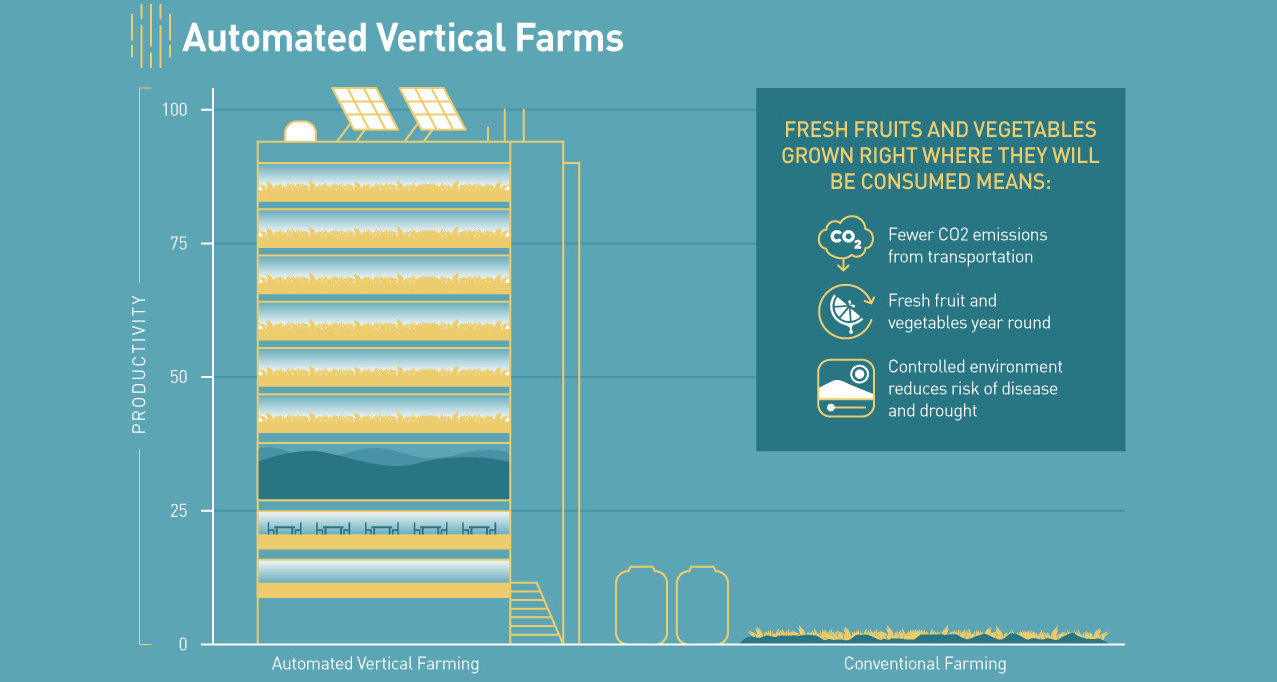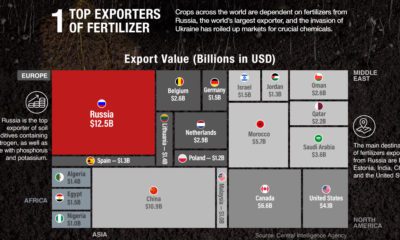Further, issues like wasted food, poor working conditions, polluted ecosystems, mistreated animals, and greenhouse gases are just some of the concerns that people have about our current supply chains. Today’s infographic from Futurism shows how food systems are evolving – and that the future of food depends on technologies that enable us to get more food out of fewer resources.
The Next Gen of Food Systems
Here are four technologies that may have a profound effect on how we eat in the future:
- Automated Vertical Farms It’s already clear that vertical farming is incredibly effective. By stacking farms on top of another and using automation, vertical farms can produce 100x more effectively per acre than conventional agricultural techniques. They grow crops at twice the speed as usual, while using 40% less power, having 80% less food waste, and using 99% less water than outdoor fields. However, the problem for vertical farms is still cost – and it is not clear when they will be viable on a commercial basis.
- Aquaponics Another technology that has promise for the future of food is a unique combination of fish farming (aquaculture) with hydroponics. In short, fish convert their food into nutrients that plants can absorb, while the plants clean the water for the fish. Compared to conventional farming, this technology uses about half of the water, while increasing the yield of the crops grown. As a bonus, it also can raise a significant amount of fish.
- In Vitro Meats Meat is costly and extremely resource intensive to produce. As just one example, to produce one pound of beef, it takes 1,847 gallons of water. In vitro meats are one way to solve this. These self-replicating muscle tissue cultures are grown and fed nutrients in a broth, and bypass the need for having living animals altogether. Interestingly enough, market demand seems to be there: one recent study found that 70.6% of consumers are interested in trying lab grown beef.
- Artificial Animal Products One other route to get artificial meat is to use machine learning to grasp the complex chemistry and textures behind these products, and to find ways to replicate them. This has already been done for mayonnaise – and it’s in the works for eggs, milk, and cheese as well.
Tasting the Future of Food
As these new technologies scale and hit markets, the future of food could change drastically. Many products will flop, but others will take a firm hold in our supply chains and become culturally acceptable and commercially viable. Certainly, food will be grown locally in massive skyscrapers, and there will be decent alternatives to be found for both meat or animal products in the market. With the global population rising by more than a million people each week, finding and testing new solutions around food will be essential to make the most out of limited resources. on But fast forward to the end of last week, and SVB was shuttered by regulators after a panic-induced bank run. So, how exactly did this happen? We dig in below.
Road to a Bank Run
SVB and its customers generally thrived during the low interest rate era, but as rates rose, SVB found itself more exposed to risk than a typical bank. Even so, at the end of 2022, the bank’s balance sheet showed no cause for alarm.
As well, the bank was viewed positively in a number of places. Most Wall Street analyst ratings were overwhelmingly positive on the bank’s stock, and Forbes had just added the bank to its Financial All-Stars list. Outward signs of trouble emerged on Wednesday, March 8th, when SVB surprised investors with news that the bank needed to raise more than $2 billion to shore up its balance sheet. The reaction from prominent venture capitalists was not positive, with Coatue Management, Union Square Ventures, and Peter Thiel’s Founders Fund moving to limit exposure to the 40-year-old bank. The influence of these firms is believed to have added fuel to the fire, and a bank run ensued. Also influencing decision making was the fact that SVB had the highest percentage of uninsured domestic deposits of all big banks. These totaled nearly $152 billion, or about 97% of all deposits. By the end of the day, customers had tried to withdraw $42 billion in deposits.
What Triggered the SVB Collapse?
While the collapse of SVB took place over the course of 44 hours, its roots trace back to the early pandemic years. In 2021, U.S. venture capital-backed companies raised a record $330 billion—double the amount seen in 2020. At the time, interest rates were at rock-bottom levels to help buoy the economy. Matt Levine sums up the situation well: “When interest rates are low everywhere, a dollar in 20 years is about as good as a dollar today, so a startup whose business model is “we will lose money for a decade building artificial intelligence, and then rake in lots of money in the far future” sounds pretty good. When interest rates are higher, a dollar today is better than a dollar tomorrow, so investors want cash flows. When interest rates were low for a long time, and suddenly become high, all the money that was rushing to your customers is suddenly cut off.” Source: Pitchbook Why is this important? During this time, SVB received billions of dollars from these venture-backed clients. In one year alone, their deposits increased 100%. They took these funds and invested them in longer-term bonds. As a result, this created a dangerous trap as the company expected rates would remain low. During this time, SVB invested in bonds at the top of the market. As interest rates rose higher and bond prices declined, SVB started taking major losses on their long-term bond holdings.
Losses Fueling a Liquidity Crunch
When SVB reported its fourth quarter results in early 2023, Moody’s Investor Service, a credit rating agency took notice. In early March, it said that SVB was at high risk for a downgrade due to its significant unrealized losses. In response, SVB looked to sell $2 billion of its investments at a loss to help boost liquidity for its struggling balance sheet. Soon, more hedge funds and venture investors realized SVB could be on thin ice. Depositors withdrew funds in droves, spurring a liquidity squeeze and prompting California regulators and the FDIC to step in and shut down the bank.
What Happens Now?
While much of SVB’s activity was focused on the tech sector, the bank’s shocking collapse has rattled a financial sector that is already on edge.
The four biggest U.S. banks lost a combined $52 billion the day before the SVB collapse. On Friday, other banking stocks saw double-digit drops, including Signature Bank (-23%), First Republic (-15%), and Silvergate Capital (-11%).
Source: Morningstar Direct. *Represents March 9 data, trading halted on March 10.
When the dust settles, it’s hard to predict the ripple effects that will emerge from this dramatic event. For investors, the Secretary of the Treasury Janet Yellen announced confidence in the banking system remaining resilient, noting that regulators have the proper tools in response to the issue.
But others have seen trouble brewing as far back as 2020 (or earlier) when commercial banking assets were skyrocketing and banks were buying bonds when rates were low.
















